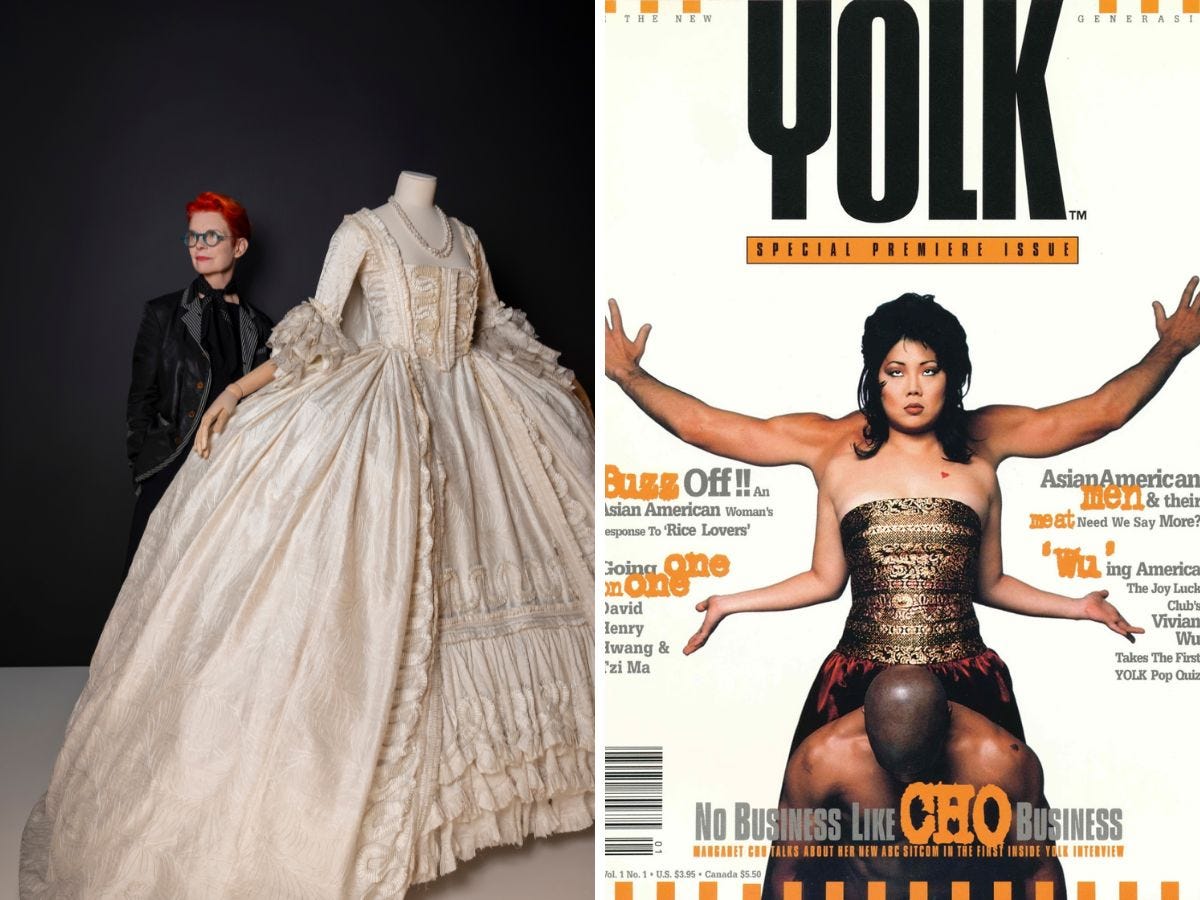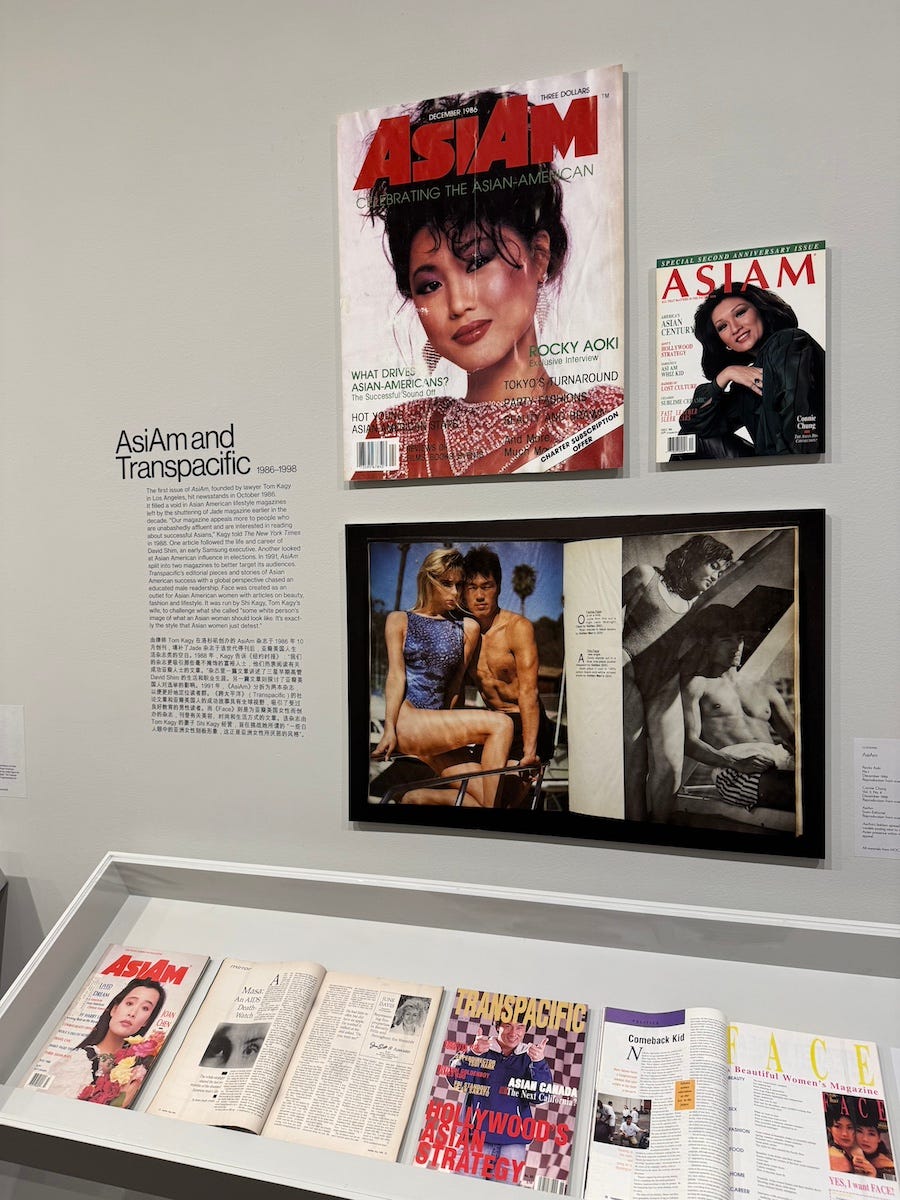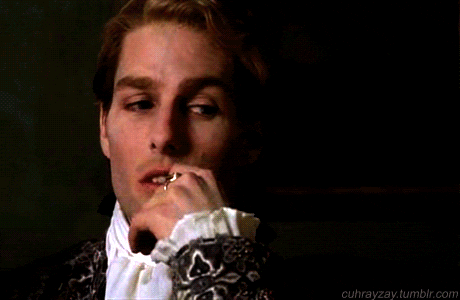Hi WNVM-ers,
First off, a massive THANK YOU to all you subscribers — we’ve been having so much fun with all of you! We’d like to give a special shout-out to paid subscribers — and our three Founding Members — for generously supporting our hard work and journalism. When we launch merch, you’re at the top of the list! So to all of you 🎶you’re making our dreams come true🎶

This week, Fawnia embraces culture (said in “Las Culturistas” tone) and visits two new exhibits celebrating singular, groundbreaking aspects of the Gen X experience. At SCAD FASH Museum of Fashion + Film in Atlanta, she talks to Martin Scorcese and Todd Haynes’ go-to costume designer Sandy Powell about supporting Gwyneth Paltrow’s first Oscar win in Shakespeare in Love, designing for a bb Kirsten Dunst for Interview With the Vampire, and more. Then Fawnia jumped on the R train to take a nostalgic journey through “Magazine Fever: Gen X Asian American Periodicals” at the Museum of Chinese in America (MOCA) — and never once considered absconding with the Russell Wong issue of Yolk magazine.
Then, in the news You Oughta Know, Cheryl catches up on what a couple ‘90s supermodels are up to, spritzes on some perfume she last wore when she was 27, and catches you up on some KeaNews.
Oh Sandy
Oscar-winning costume designer Sandy Powell looks back on her game-changing work in the ‘90s, and turning Top Gun star Tom Cruise into an 18th century vampire.
By Fawnia
During the media preview for “Sandy Powell's Dressing the Part: Costume Design for Film,” I first hightailed it over to the triple-Oscar-winner’s stunning work from more recent fare: the avant garde 18th Century gowns in The Favourite, animation-brought-to-life in Mary Poppins Returns, and futuristic ‘70s punk in Elle Fanning’s teenage alien love story, How to Talk to Girls at Parties.
Surrounded by vignettes covering three decades of her acclaimed work, Powell briefly mentioned Neil Jordan’s 1992 IRA mystery thriller The Crying Game to me and memories came flooding back. I remember watching it with my core group of college friends, including vintage t-shirt collector Aldo, and afterward, we talked about it for days, weeks — always a sign of a good movie. (I mean, the film did win Jordan a screenwriting Oscar, a BAFTA, and a bajillion other nominations.) Starring Stephen Rea as an IRA member, Forest Whitaker as a British soldier, and Jaye Davidson, as his girlfriend Dil, the film uses the political landscape of the period to explore and subvert race, nationalism, sexuality, and traditional gender norms.

I texted Aldo a pic of Dil’s gold sequin mini-dress, on a mannequin posed as if in mid-performance, and asked if it looked familiar. His immediate response: “the crying game? neneh cherry? rifat ozbeck?!” Ding ding ding on the first one! His response: “It made an impression on the culture!!!” (I did always wonder if Neneh Cherry was an inspiration for Dil and kicking myself for not asking Powell in Atlanta.)
But the point: Powell’s costumes started our discussion up again, further confirming that she’s been on the forefront of pushing boundaries of societal convention, and exploring gender expression with her work.
“It started with Derek Jarman films in the ‘80s,” says Powell, referring to her late friend, filmmaker, and gay rights activist. The duo collaborated together on six projects, including the 1986 seminal queer film, Caravaggio — her first costume design job. “His films, right from the start, were breaking boundaries back then.”
Powell continued challenging traditional standards through costume and storytelling into the ‘90s — and still does — like, the gender-bending 1992 period fantasy Orlando, also-starring Tilda Swinton, and Todd Haynes’ 1998 glam rock, Ziggy Stardust-referential musical drama, Velvet Goldmine. (Both movies are represented in the exhibition, also illustrating her expansive period costume design acumen.) As a member of “Generation Jones” (the “Xennial” of Boomers and X-ers) Powell also credits her own pop culture influences, like David Bowie, from her formative teen years in the 1970s.
“T. Rex was the first record I ever bought when I was 11,” says Powell, about the glam rock band, which, along with Bowie, begat Duran Duran and the New Romantic movement, and my beloved hair metal acts, like Mötley Crüe and Poison. “I liked [lead singer/guitarist Marc Bolan] because he was beautiful. He had curly hair, really pretty, and he wore ‘ladies’ shoes.’”

Working with English filmmaker John Madden for his 1998 hit Shakespeare in Love — a.k.a. that time when then-ingénue Gwyneth Paltrow and Good Will Hunting scribe Ben Affleck dated — earned Powell her first Oscar. (Fun fact: Powell went up against herself with a concurrent nomination for Velvet Goldmine.)
In the Elizabethan era-set film, Paltrow’s young noblewoman Viola de Lesseps prevails against societal limitations by dressing as a boy, “Thomas,” to realize her acting ambitions and ventures off the expected traditional path. Viola’s doublet disguise as Thomas, and her resplendent gold brocade dress, with the shimmering Art Deco lace whisk, greet guests as they enter the exhibition. Powell has described Paltrow’s costumes as “relatively simple,” “grand but never brash,” and “just what suits Gwyneth.”
“It wasn't about making [Viola] look like the most fantastic looking woman in the film because really, the story is about her disguising herself as a boy and the love story [between Viola and Joseph Fiennes’ Will Shakespeare],” says Powell, looking back — and at — Viola’s ensembles, which do feel somewhat understated, next to Judi Dench’s majestically elaborate Queen Elizabeth I gowns. “Saving the grandeur for the palace and the queen.”
Powell’s costumes also supported Paltrow embodiment of her role/s, which resulted in her first Oscar (and a spot in the red carpet hall of fame with her Barbie pink Ralph Lauren gown.) The future Goop entrepreneur wasn’t the only breakout Hollywood superstar that Powell costume designed for that decade.

Turning the corner in the exhibit, we reach the vignette for 1994’s Interview With the Vampire, with Kirsten Dunst’s pint-sized en vogue à Paris in 1870 blue ball gown, with delicate beaded embroidery, elaborate draping, and intricate corsetry. “It was actually quite an interesting thing to design for an 11-year-old, who's actually an adult,” says Powell, about Dunst’s character Claudia, a ruthless 70-year-old vampire killer trapped in the body of a tween. (Although, in the current AMC series Claudia is a hormonal 14 year old, which would legit be the absolute worst age to remain for all eternity.)
Positioned in between Brad Pitt’s natty late-19th century suit and Tom Cruise’s opulent gold embroidered and blue velvet brocade 1790s-ish ensemble, Claudia’s ornate dress, which represents her vision of her true self, looks especially diminutive. “It was quite nice doing the miniature adult version,” continues Powell. “But the thing is, it really helped that it was someone like Kirsten. I mean, really, she was 11 going on 40. She was so smart and bright. She wasn't a precocious little ‘child actor.’”
In his memoir released over the summer, the film’s director Jordan also addressed the initial backlash to casting Maverick as a blonde, six-foot-tall and 200-year-old French aristocrat, Lestat de Lioncourt, as described in Anne Rice’s books. (Daniel Day Lewis, whose Gangs of New York menacing Bill the Butcher costume is also on exhibit at SCAD, turned down the part) I still think Cruise is forever, as they say, an actor with a “face that knows about text messaging” (or in early-‘90s parlance, “sending a fax.”)
“[Cruise was associated with] contemporary and action movies,” says Powell, whose period costumes did help us all embrace Cruise as a circa-1800s blood-sucking dandy. “I wasn't thinking of doing ‘the Tom Cruise version’ of Lestat. I was doing the Lestat that Anne Rice created. So he had to adapt. The camp — he did it really well. That was the challenge for him, wasn't it? He was going to go against type, and with a blonde wig.”
Especially in the age of streaming, and rapidly shrinking movie-making budgets, Powell looks back on the ‘90s fondly; likening her formative years in the free-spirited ‘70s to the subversive energy of the ‘90s London creative scene in which she thrived.
“I was lucky to be right in the boom where everything was changing and it was exciting,” says Powell, who won’t stop pushing the envelope or kick-starting conversations through costume anytime soon. “Personally, I'm not interested in doing films that are formulaic. I'd much rather be working the directors who are taking risks.” Coming up next: Marc Webb’s reimagined Snow White, co-written by Greta Gerwig, and Maggie Gyllenhaal’s mysterious The Bride, a ‘30s-set Dr. Frankenstein-type story with more socio-political commentary.
‘Sandy Powell's Dressing the Part: Costume Design for Film,’ featuring over 100 costumes from nearly 30 films, runs through Sunday, March 16, 2025 at SCAD FASH Museum of Fashion + Film, 1600 Peachtree St. NW, Atlanta, GA.
On the Cover of a Magazine
A new exhibit chronicles the rise and impact of Gen X Asian American magazines, with early covers featuring icons Lucy Liu, Margaret Cho, and, of course, Joan Chen.
By Fawnia

Growing up in a homogenous Midwestern suburb in the pre-Internet age, I gleaned my culture and news from television (shocker, I know), movies, and — what’s that now? — print magazines, like YM, Mademoiselle, The Face, if my dad went on a biz trip to London, and that supersized TV Guide fall preview issue. (Sorry, I’ve never been a Vogue girlie.) But my very sharp and perceptive educator mom always knew the stealth ways to broaden my horizons, like subscribing me to the progressive Sassy and John F. Kennedy Jr.’s George, when it launched as a cool, young pop culture-meets-politics magazine — and not some scary QAnon conspiracy pub.
One day, my mom presented me with a subscription to Transpacific, a glossy, glam-looking mag, just like the ones in my regular rotation. But this was the first time I set eyes on an issue showcasing Asian Americans across business and politics, and the only sections I’m sure I read: entertainment and fashion. My mom was good. She knew exactly how to expose me to a more diverse (and probably aspirational) range of Asian American representation and self-expression, as I went on my own journey of self-exploration and identity. Shiny pages and celebs!

My memories aren’t super clear, but I must have scoured issues to find pages of Russell Wong to rip out and tape up next to Jon Bon Jovi on my bedroom wall, and just marveled at a Joan Chen cover. From there, I kept seeking out a growing number of intriguing Asian American pubs, like the aforementioned Yolk, highlighting pop culture with a political undercurrent (and recently resurrected as a podcast.) I swear my The Crying Game crew all flipped through the Margaret Cho issue together, and Aldo definitely bought the more alternative Giant Robot from Tower Records.
So, when I received an invitation to preview the October opening of ‘Magazine Fever: Gen X Asian American Periodicals’ at Chinatown’s MOCA, I thirstily RSVP’d immediately and maybe even showed up before the official start time.

The exhibition is arranged chronologically, which emphasizes the evolution, progress, and continuous challenges — starting with Gidra, the first Asian American newspaper founded by Japanese American students at UCLA. The intro leads into more grassroots social activism broadsheets — some even hand-written — distributed mostly on college campuses in the ‘70s, which was illuminating. The exhibition touts the ‘80s and ‘90s as “a blossoming golden age” for Asian American publishing. Dovetailing with technology of the time, the movement harnessed the creativity, skills, and interests of Gen X Asian Americans yearning for self-expression and representation, and breaking from the model minority myth. (Yeah, that 1987 Time magazine “Whiz Kids” issue — with the most trope-y props, btw — is also on display, serving as a comparison point to what Asian America really looks like when we take charge of our own narrative.)
“I'm really interested in the way the magazines we're showing tried to frame Asian American stories into the spectrum of American popular culture of the ‘90s,” says Herb Tam, MOCA’s Curator and Director of Exhibitions, and fellow X-er. “They resisted the depictions of Asian Americans as geeks and model minorities that were part of the American imagination, but they also offered an alternative or an expansion of the idea that Asian American culture was defined by radical politics of the 1960s and 70s.”

Slow-walking through, I spotted issues of my pivotal Transpacific, and its precursor AsiAm, leading into A. Magazine: Inside Asian America, which remained a steady presence in my young adult life, maybe because they also co-sponsored dance parties we’d go to in college. I took in so many formative, to me, covers: Filipino American singer Jocelyn Enriquez (“Do You Miss Me” still slaps), “21 Jump Street” (and, recently, “Warrior”) actor Dustin Nguyen, and forever icon Lucy Liu.
“The magazines we're featuring created representations of Asian Americans that hadn't been realized before,” says Tam. “They gave Asian American writers and photographers some of their first major opportunities, and they featured people who would later go onto greater fame: Michelle Yeoh, Ali Wong, and Sandra Oh.”

A framed two-page spread especially spoke to me, with fake, kinda satirical reimaginings of ‘90s popular TV show formulas, but with Asian American actors, like, yes, Russell Wong, populating the cast. (“Monterey Park 91754” lol) Notably, roughly two decades later, Hudson Yang, son to A. Magazine co-founder Jeff, would star in the Taiwanese American ABC comedy Fresh Off the Boat, which ran from 2015 to 2020. (The elder Yang also chronicled the blood, sweat, and tears behind running A. Magazine from 1989 to 2002 in the New York Times bestseller Rise: A Pop History of Asian America from the Nineties to Now. Check it out — I’m a contributor!)
It also felt heartening to see the decades-old titles and issues exploring and discussing multiculturalism and allyship with fellow underrepresented communities, as well as examining defining Gen X history, including the AIDS crisis and the Rodney King case and Los Angeles uprising in 1992.
Reflecting the media industry in general, the Asian American print periodical heyday began winding down in the aughts. Audrey, which featured “New Girl”’s Hannah Simone, Priyanka Chopra, and singer-songwriter Yuna on its covers, lasted until 2015. I also discovered some post-Y2K, but pre-Instagram publications, like Hyphen that sadly never even crossed my radar. So I did appreciate the opportunity to take in all the titles, creativity, and expression that I missed.
I’m also bummed that my late mom isn’t here to see the exhibition with me. She would have loved the evolution, and the impact, and had lots to say, I’m sure. But I like to think she played a part in making it happen.
‘Magazine Fever: Gen X Asian American Periodicals’ runs through March 30, 2025 at Museum of Chinese in America (MOCA), 215 Centre Street, New York, NY 10013.
We are two Gen X journalists who analyze all the '80s and '90s nostalgia in current pop culture, fashion, and beauty. Read more stories like this one here!
You Oughta Know
For more Gen X culture, jet across the pond to the Fashion and Textile Museum in London for the “Outlaws: Fashion Renegades of ‘80s London,” running through March 9, 2025. (H/t costume designer Lynsey Moore.) Centered around Leigh Bowery’s famously debaucherous nightclub and Boy George haunt, Taboo — tagline “dress as though your life depends on it, or don’t bother.” The exhibition features one-of-a-kind pieces from Bowery, and over thirty designers, including John Galliano, and more memorabilia. [Time Out/Instagram]
Clinique made its 1997 perfume juggernaut, Happy, into a body mist (read about mist popularity here) to try to attract Gen Z interest. Did Cheryl go out and immediately buy a rollerball of the scent to bring back memories of her 20s? Yes, and it still smells great. [Glossy]
Two ‘90s models are doing stuff: Kate Moss, who just walked the rebooted Victoria’s Secret Show with her daughter Lila Moss, is launching a capsule collection of “party wear” with Zara, designed in part by former Alexander McQueen stylist, Katy England. And Claudia Schiffer appears in ads for the Hailey Bieber-owned skincare brand, Rhode. She hypes its new “Barrier Butter,” a thicker hydrating balm. A play for Gen X and our crepey skin? Possibly. [Harper’s Bazaar, Cosmetics Business]
In nostalgia documentary news, Jane Fonda, Lily Tomlin, and Dolly Parton all take part in a new docu about the 1980 classic, 9 to 5. (Prime Video, Apple TV, Google Play). Plus, Super/Man, the “gut-wrenching” story of Christopher Reeve, is in theaters now. And this is not a docu, but we cannot skip any pertinent Keanu Reeves news here at WNVM. On the occasion of Speed’s 30th anniversary, he told a festival audience that they “actually hit cars” on set. [Deadline, New York Times, Deadline]
For much, much less than self-publishing your own glossy magazine, please consider supporting us and upgrading your subscription here:








I feel EXTREMELY targeted by this newsletter!! Love love love it. And I would faint if I saw Gwyneth's Shakespeare gown in person!
Still love Interview with the Vampire, and Cruise was actually great in it. Those costumes were so exquisite - Powell is a genius.